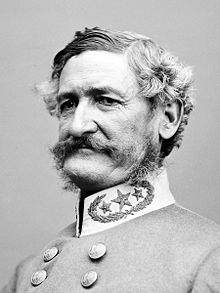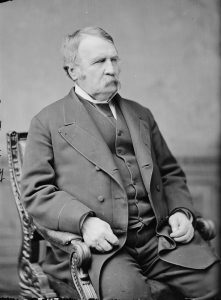The Abolition of Debt Peonage Slavery in New Mexico Territory, Part 1

Emerging Civil War welcomes guest author Ray Shortridge
Red, white, and blue Texas Lone Star battle flags rippled in the sharp autumn wind as the Fourth Texas Mounted Infantry trotted west from San Antonio on October 23, 1861.[1] A few weeks later, the Fifth Texas Mounted Infantry left Fort Bliss, followed by the Sixth Texas on November 20.[2] Two batteries, each with four twelve-pound mountain howitzers, accompanied this three thousand strong brigade. Jefferson Davis had ordered the commander of this force, Brigadier General Henry Hopkins Sibley, to drive the Federal troops from New Mexico Territory to fulfill his dream of extending chattel Negro slavery into the Southwest and Northern Mexico.[3]
Sibley believed that the Union fielded three Union infantry regiments and a few companies of regular cavalry to face him, and likely to be reinforced by New Mexico militia and volunteers. Sibley felt confident that he could defeat the federals. The task did not seem daunting because, earlier, in August, Lieutenant Colonel John R. Baylor’s approximately three hundred Texas cavalry routed and captured approximately five hundred Union infantry near San Augustin Springs, about ten miles east of Mesilla, New Mexico Territory.
Yet, only a few months later, in the early spring of 1862, starving remnants of the Sibley Brigade staggered back to El Paso, most of them on foot, having lost thousands of horses and mules. Sibley’s troops also left perhaps fifteen hundred of their companions back in New Mexico, dead from combat or disease, wounded or missing. Davis’ dream of a Southwestern empire served by chattel Negro slaves was destroyed. However, another form of involuntary servitude indigenous to New Mexico, debt peonage, remained a viable institution until outlawed by Congress in 1867.
In his July 10, 2018, posting to ECW, Neil P. Chatelain pointed out that chattel slavery continued in the United States after the 13th Amendment (1865).[4] Not until treaties that incorporated the language of the 13th Amendment were signed by the slave-holding Five Civilized Tribes in the Indian Territory (now Oklahoma) in 1866 was the last vestige of chattel slavery outlawed. However, a form of unfree labor, debt peonage, legally persisted another year in New Mexico Territory until the enactment of the federal Peon Law in 1867.[5] In his memoir, United States Attorney for New Mexico Henry Davis asserted that “peonism is but a more charming name for a species of slavery as abject and oppressive as any found on the American continent.”[6]
Debt peonage puzzled Americans venturing down the Santa Fe Trail into New Mexico in the early Nineteenth Century. Their frame of reference for bondage was the chattel slavery of black people practiced in the South. To the Americans, the Ricos (rich masters) were of the same race as their peon servants, with many Americans characterizing all of the Nuevo Mexicanos, regardless of class, as “mongrels,” a blend of Spanish, Moorish, and Indian blood.[7] Unlike slavery in the American South, the Ricos did not own their peon servants as property. One of the earliest to publish a description of debt peonage, the Santa Fe Trail merchant, Josiah Gregg, observed that the basis for the practice was that a debtor who defaulted could either serve a term in prison or provide the creditor with his services until the debt was satisfied.[8] If a peon departed for employment elsewhere, the master had the right to have a magistrate fetch him back into his service. Lieutenant W. H. Emory, a geographical engineer with the Army of the West that conquered New Mexico for the United States in 1848, recounted that a boy who “had been engaged [by the Army] to go to California as arriero (mule driver), was to-day claimed by his creditor or master.”[9] The peon could also bind his children to the debt so that they, too, toiled as peons.[10] Death did not expunge the peon’s debt; the debtor’s children were obliged to labor for the master to pay off the deceased’s obligation.[11]

American observers were quick to spot the trap that transformed working off a debt into the perpetual bondage of peonage. Gregg noted that the peon rarely received “any money, but instead thereof, articles of apparel and other necessaries at the most exorbitant prices. The consequence is that the servant soon accumulates a debt which he is unable to pay — his wages being often engaged for a year or two in advance.”[12] Like Gregg, Emory saw the economics of the trap. The boy muleteer referred to above, “owed the man $60, and was, by the law of the country, paying his debt by serving at $2 per month; out of this he was to feed and clothe himself, his master being a sutler. It was plain he could not pay his debt in his lifetime.”[13]
Gregg believed that debt peonage “acts with terrible severity upon the unfortunate poor, whose condition is but little better, if not worse indeed than that of the black slaves of the South.”[14] Emory noted that peons were “as a class, the cheapest laborers in the world. The price of the labor for life of a man was, in the case we have stated, $60, without any expense of rearing and maintenance in infancy or old age, the wages covering only a sum barely sufficient for the most scanty supply of food and clothing.”[15] The price of a male Negro slave in the Southern slave markets at the time was several hundred dollars.
The class of large landholders within the Spanish empire in America faced a shortage of labor to cultivate crops, provide household service to the hacienda, and tend livestock. These agricultural pursuits did not require a level of technology that justified investing in mechanization. In Eighteenth Century New Mexico, sheep became the basis for wealth, stimulating the demand for shepherds. Captive Indian slaves were too few to meet the growing demand, and New Mexico faced a chronic shortage of money to pay Nuevo Mexicanos for their labor. The Ricos used their political power to legislate measures that forced numerous landless workers into debt peonage.
To be continued…
Sources:
[1] John P. Wilson and Jerry Thompson, The Civil War in West Texas & New Mexico, The Lost Letterook of Brigadier General Henry Hopkins Sibley, (El Paso, TX, 2001), p. 61.
[2] Ibid.
[3] The War of the Rebellion: A Compilation of the Official Records of the Union and Confederate Armies, 128 Volumes, (Washington, D.C., 1880-1901), Series I, [hereinafter noted as OR], Vol. 4, Chap. 9, 93.
[4] Neil P. Chatelain, “Beyond the 13th Amendment: Ending Slavery in the Indian Territory,” (Emerging Civil War Blog; July 10, 2018).
[5] Congress never addressed the plight of thousands of captive Indians who were held in bondage by Anglos and Hispanics in the Trans-Mississippi West.
[6] W. W. H. Davis, El Gringo, or New Mexico and Her People (New York: Harper and Brothers, 1857), 232.
[7] See, for example: P. St. Geo. Cooke, The Conquest of New Mexico and California: An Historical and Personal Narrative (New York; G. P. Putnam’s Sons; 1878), 39. Davis, El Gringo, 216.
[8] Josiah Gregg, Commerce of the Prairies (Santa Barbara; The Narrative Press; 2001), 158.
[9] Ross Calvin, ed., Lieutenant Emory Reports: A Reprint of Lieutenant W. H. Emory’s Notes of a Military Reconnoissance (sic) (Albuquerque; University of New Mexico Press; 1951), 87.
[10] Davis, El Gringo, 233.
[11] See, for example, the legal case: Jaremillo v. Romero, 1857-NMSC-007, 1 N. M. 190 (S. Ct. 1857).
[12] Gregg, Commerce of the Prairies, 158.
[13] Ross Calvin, ed., Lieutenant Emory Reports, 87.
[14] Gregg, Commerce of the Prairies, 158.
[15] Ross Calvin, ed., Lieutenant Emory Reports, 87.
Actually I think that Davis was looking for the Colorado silver and gold fields; they knew how cash poor the Confederacy was. Most members of the Confederacy knew that slavery was climate specific and limited, save for the real fire eaters.
He should have arranged for somebody who was not a “walking whiskey keg” to lead the effort.
Ah Sibley, the Walking Pub!
While it may have been near impossible to use chattel slaves for plantation agriculture in the West, I don’t think the author’s statement is inaccurate, in that it was likely that chattel slavery could and would have been adapted to large-scale metal mining operations. In fact, given the manpower shortage in the South, that may have been the only economic model on which the Confederacy could have capitalized.
I had not been aware of debt peonage in New Mexico before reading this article. However a third kind of slavery, that of detribalized Indian captives who were forced into domestic service, hispanicized, and eventually constituted a caste called Genizaros or else blended into the general Mexican poblador population. It wasn’t exactly chattel slavery. These were extremely common since the war between the settlers and the Pueblos on the one side and the nomadic tribes on the other lasted from 1598 all the way through the 19th century. Hampton Sides, in “Blood and Thunder” tells a story about the Civil War general Myles sent out to New Mexico by the War Dept. in 1867 to check on the mess at Bosque Redondo who was shocked to find slaves in almost every officials’ homes that he entered, including that of the Governor and of Kit Carson. And that was after Carson had fought for the Union.
Can someone clarify what this form of slavery should be called? In Spanish the slaves were called “criados,” meaning “those who were raised (in the home),” Household slavery? Often they married into the owning families.
Rudd correctly identifies another unique form of unfree labor in the southwest, that of the criados. James F. Brooks, in his book, Captives and Cousins: Slavery, Kinship, and Community in the Southwest addresses these issues in some detail. His work suggests that what Rudd characterizes as “often they married into the owning families” is a euphemism for raping young native women who were dwelling and living in the spanish/hispanic household. Brooks demonstrates that deracinating young indian women and men was a deliberate spanish and mexican policy to attenuate indian cultural presence in the southwest. And, Brooks points out, that the Navajo and various Apache tribes also practiced deracinating hispanic captives, as did the comanche with their hispanic and anglo captives.
Good article. Keep in mind that Slavery in America is actually a ‘perfected’-hybrid system of European Slavery — primarily a combination of English, French, and Spanish forms of slavery (e.g. ‘indenture’, physical ownership ‘slavery’, and ‘peonage’).
For example, look at the English Royals. The Queen personally owns 2/3s of the land mass of Canada and lives in multiple palaces paid for and maintained by the English populace.
Spanish slavery was never abolished. America’s treaty acquisition of several of the Carribean Islands included provisions to maintain the status quo — as did the Louisiana Purchase.
English slavery, though ‘officially’ abolished, evolved into the Spanish Peonage system. The English system evolved into the New Peonage — run out of Lloyds of London. It’s what we call the “Insurance” industry today. Add “Compulsory” to the word “Insurance” — you have “Compulsory Insurance.” “Compulsory Insurance” is the new name of Peonage.